Croton transplantation at home, features of care and breeding

Many gardeners like to grow not only flowering plants, but also evergreens, with rich greenery and high decorative qualities. It belongs to these colors croton.
Content:
- Description of the codeum
- Plant varieties
- How to care for codiaum
- How to replant a flower?
- Pest and disease control
- Methods for propagating codiaum
Description of the codeum
Croton, or codiaum, belongs to the Euphorbiaceae family. The flower got its name from the Greek language: Codeia means “head”. It is an evergreen deciduous shrub, with variegated leathery shiny leaves and semi-lignified branches.
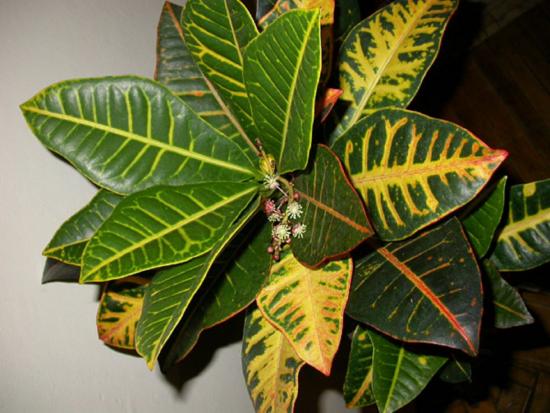
Juice poisonous, released when the crown and branches are damaged. The color of the leaves is green, with bright red veins and numerous yellow, pink, and purple inclusions.
In nature, codiaum can reach 1.5 - 2 meters, and in indoor conditions, as a rule, it is a low bush. The shapes vary depending on the height: they can be oval, elongated, wide, with smooth or wavy edges.
Bloom in Croton this happens quite rarely, and these flowers look completely undecorative: collected in a hanging raceme, they are light and inconspicuous. Therefore, flower buds are almost always plucked out so that the plant does not waste energy and juices on them.
Homeland - South Asia, the islands of Australia and the Pacific Ocean.
Plant varieties
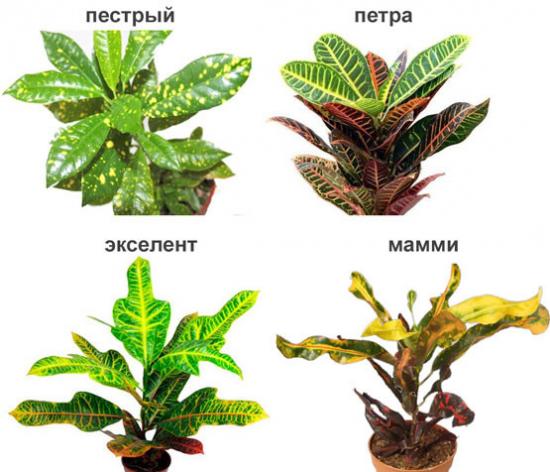
The most interesting types of croton are:
Petra
This species forms a lush bush with numerous branches, oval-shaped leaves, bright green with yellow veins, arranged alternately.
Zanzibar
The leaves of this species are lanceolate, narrow, denser than usual. Burgundy, yellow, and purple stripes are clearly visible on them.
Exhibitor
The crown of the bush is very reminiscent of oak leaves due to its fused three-lobed leaves. They have white, burgundy spots and stripes, and there is more pink on the lower surface.
Mrs Eyeston
It occurs in the form of a bush or small tree. The leaves are elongated, wide, with smooth edges and have pink, purple spots and golden streaks.
How to care for codiaum
This overseas guest is quite demanding in terms of growing conditions and care. Loves high humidity and temperature, as in the tropics, so the ideal growing option is greenhouses or indoors greenhouses. But drafts are simply contraindicated; you cannot take the container with the flower outside, or leave open windows nearby, especially during the cold season.
Care consists of several components:
- Choosing a location.
- Watering.
- Temperature regime.
- Lighting.
- Feeding.
- Pest control.
- Properly organized wintering.
The plant needs a well-lit place with simultaneous protection from direct sunlight; east and west windows in the house are the best place for pots.
From lack of lighting, the leaves lose color and become faded and colorless. In winter, daylight can be supplemented with artificial lighting in the form of simple 100-watt light bulbs suspended at a distance of 70-75 cm from the crown.
Temperature for growth plays a very important role.The temperature should be constant, in winter not lower than 16 degrees, and in the rest - up to 25 degrees.
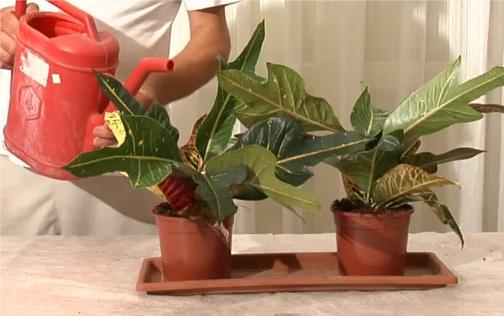
Water The flower should be grown in moderation, constantly keeping the soil in the pot moist, but not overfilling it with water. To prevent the soil from turning sour and not being too heavy, use a pot with drainage holes and a tray with gravel.
Water for irrigation is used at room temperature; the plant may have an unpredictable reaction to watering with cold water. It is useful to frequently spray the crown with a spray bottle; in this way you can temporarily humidify the air around the pot.
Dry air contributes to the drying and falling of leaves, as well as the proliferation of weevils and spider mites.
Such dry croton branches need pruning, but be careful, pruning releases a poisonous white milk. In addition to spraying, it is worth wiping the bright leaves as they become dirty for full photosynthesis and gas exchange.
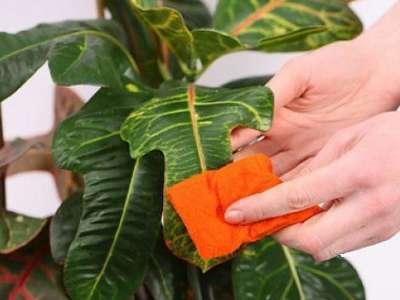
During the growing season, it is necessary to apply mineral fertilizers according to the following scheme: 2-3 times in spring, summer and autumn, and in winter once is enough. Fertilizers should be purchased in specialized stores and carefully read the instructions.
How to replant a flower?
Codiaum does not require frequent transplants, for a young bush, replanting is necessary 1-2 times a year, and for older flowers much less often, in the spring, depending on the speed of root growth. The bush for transplantation must be completely healthy and should not bloom, otherwise it may quickly die.
The pots chosen are plastic or clay, with large drainage holes; shards or charcoal are placed on the bottom.Transplantation occurs in a transshipment manner, that is, you cannot disturb the clod of earth from the previous pot, but only carefully remove it and move it to a new one, several cm larger in diameter than the previous one.
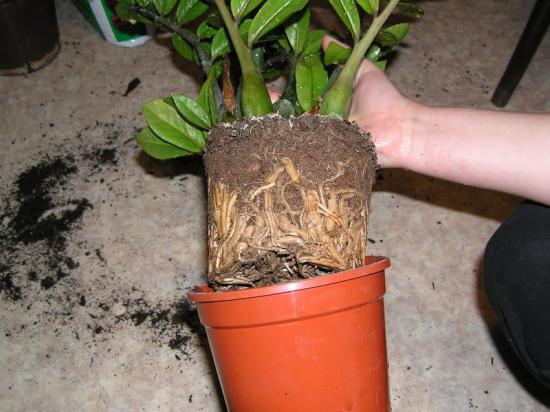
The usual soil mixture is used for indoor ornamental plants. The main thing is that it should be light, well-drained and breathable.
You can buy soil at flower shops, or you can prepare it yourself by mixing:
- Leaf soil.
- Turf.
- Well-rotted manure.
- Peat.
- Coarse river sand.
Sometimes charcoal is added to this mixture as a disinfectant, or the soil is spilled with a weak solution of potassium permanganate before planting and dried. Place drainage in the bottom of the pot, pour soil mixture on top, lightly water it and make a small hole.
The codiaum is placed in this hole along with a lump of earth and all remaining voids are filled with soil, slightly pressing it down, and the transplanted flower is well watered.
Organization of wintering. In winter, codiaum is grown in bright rooms with a constant temperature of 17-18 degrees and the leaves are constantly kept clean by wiping them with a damp soft cloth to remove dust.
Pots can be placed close to radiators and radiators, and moss can be placed on the surface of the potting soil to slow down the evaporation of moisture.
Pest and disease control
Diseases often occur as a result of improper care, non-compliance with temperature and watering regimes. Constant exposure to sunlight will cause burns on the leaves, and a lack of light will lead to their fading and loss of brightness.
Stagnation of moisture in the pan leads to rotting root system. And with infrequent watering and low humidity in the room, the ends of the leaves begin to turn brown and then dry out completely.
The plant is poisonous, so many pests avoid this tropical guest, but with constant dry air and rare spraying and washing of the branches, spider mites, weevils and scale insects settle on it.
Arachnoid mite - a small red spider that lives on the back of the sheets and entangles them with its white web. Removal is quite simple: it is necessary to wash the crown, especially from the underside, with a weak soap solution, tobacco infusion, or regularly treat it with insecticides. Acaricidal drugs (Neoron) are used. After using the soap solution, it is washed off after a few hours with plain water.
Fighting scale insects is more labor-intensive and takes more time. Adults are covered with special “shields” that do not allow any chemicals to pass through and protect the pest. At first, the scale insects are invisible, but after some time the branches become covered with dark spots containing adult individuals, and the larvae crawl out from under the scales.
The treatment is carried out repeatedly to completely eliminate the scale insects. They use soap and tobacco solutions, sometimes adding denatured alcohol or a product purchased at a specialized store. And insects under the shields are removed with a slightly damp cotton pad, wiping all stems and leaves.
Methods for propagating codiaum
Croton reproduces in three ways:
- By cuttings
- Dividing the bush
- Seeds
When breeding cuttings healthy stem cuttings from woody shoots are selected. The cuttings should be 7-10 cm in length; they are cut in late spring or early summer.
Before planting, they need to be rooted; this is done in warm water at 23-24 degrees; you can use various root growth stimulants. Such cuttings grow into powerful, strong bushes that are adapted to indoor conditions.
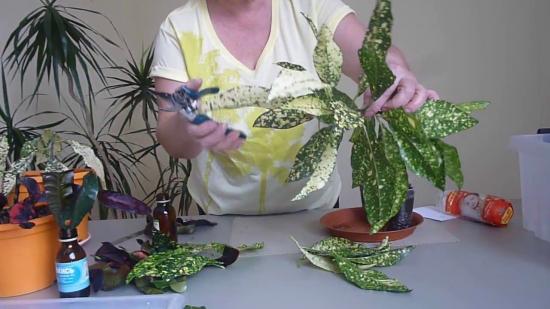
Rooted cuttings are sown in prepared pots with a diameter of 6-7 cm; soil is purchased or made independently, mixed in a ratio of 2:1:1/2:
- Leafy ground
- Sphagnum
- river sand
To stabilize the cutting, stick a stick next to it. Until the cuttings are completely rooted, the soil in the pot should always be moist, and after complete rooting they are gradually accustomed to loose soil and air flow, and then transplanted into containers of larger diameter.
If the bush has grown too much and is cramped in the pot, it is necessary to divide it and replant it in different pots. Division, as well as cuttings, is carried out in the spring. First, new pots and soil are prepared, and the bush itself is well watered one day before dividing.
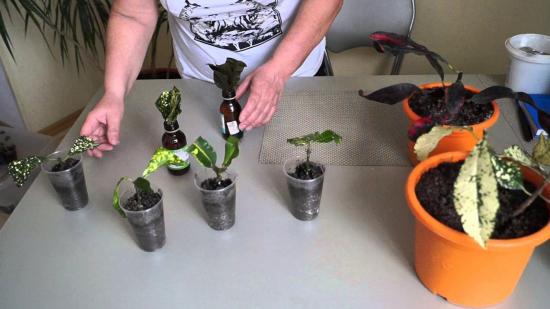
Planting is done as follows: the flower is carefully taken out of the pot and divided into several parts: the main bush and small basal children. The adult bush itself is transplanted into a large container, and small children are planted in small containers, covered with plastic film or glass and placed in a warm place.
For good establishment, the bushes are watered daily, keeping the substrate moist and maintaining a temperature of about 30 degrees at the roots.
Propagation by seeds is the most difficult method, since croton rarely blooms and the seeds do not ripen well. Seed material is purchased ready-made or collected yourself. After flowering, the seeds form in a capsule, they are collected and sowing begins towards the end of winter.1-2 days before sowing, it is advisable to soak the seeds in special preparations, for example, with root to improve germination.
The seeds are distributed over the surface of the pot, lightly sprinkled with a sand and peat mixture and covered with glass or film. Every day the cover must be removed, ventilated and sprayed on the soil surface.
Seeds usually germinate within 21-30 days.
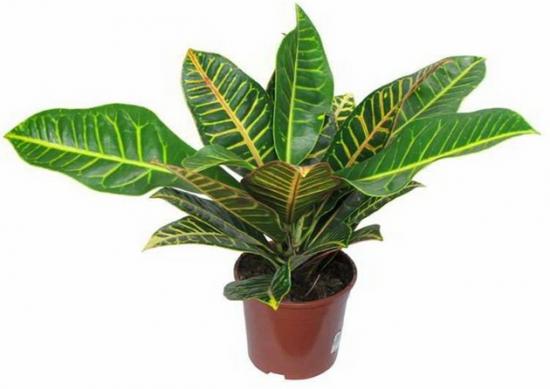
Croton is a beautiful ornamental plant that requires a little more attention than other pot inhabitants. And if the grower provides it with the proper conditions and care, it will show itself in all its glory and will delight you with its bright foliage for a long time.
Watch the video on how to replant croton after purchase:

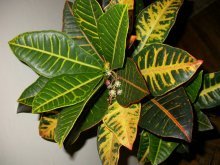

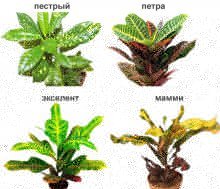
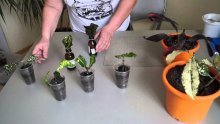
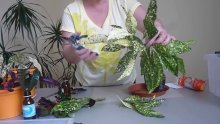
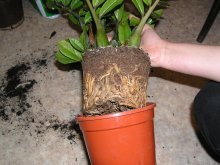
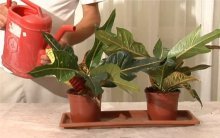
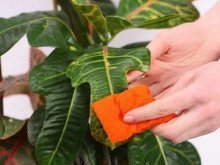

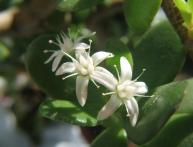
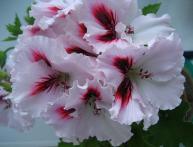



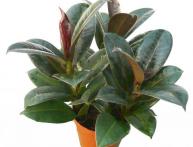
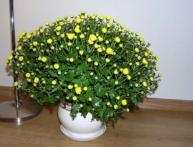
Comments
I really like ornamental plants; croton is amazingly beautiful and will decorate any room. But I was still alarmed by the fact that the sap of the plant is poisonous. I refused this handsome guy in the house.
Croton or codeum is a very beautiful flower. But I just can’t tame him. A very whimsical creature. The biggest one lives with me for six months and dies. I've already tried it many times, and it seems like I'm doing everything right. I bought the Petra variety and Mammy.